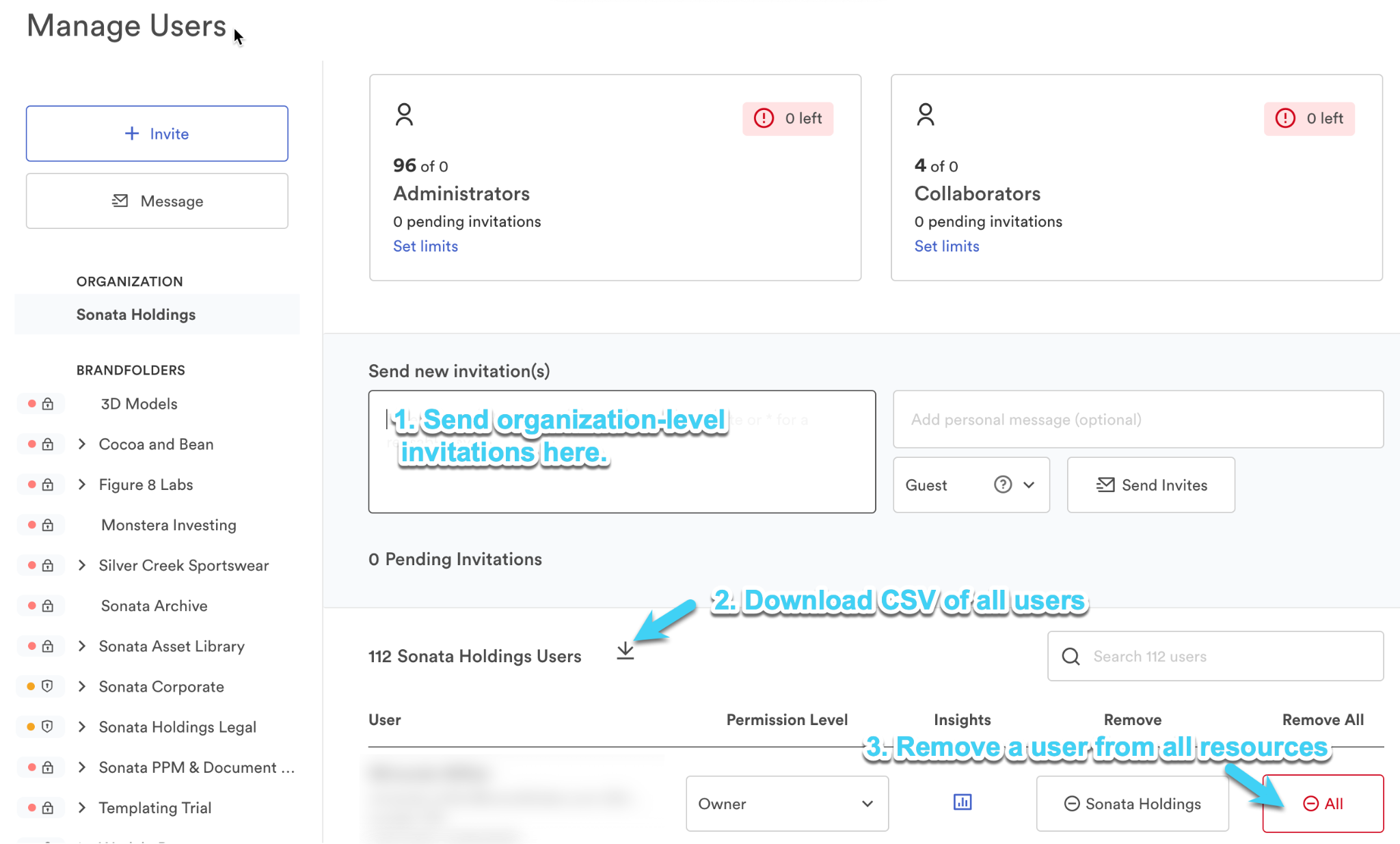Learn how to manage your users at the Organization, Brandfolder, and Collection level.
You can manage users through the Users Modal on the Organization level and the Users Page on the Brandfolder and Collection level.
Organization-level user management modal
At the organization level, navigate to Settings > Manage Users.

At the Organization level, there are a few essential capabilities:
- Invitations must come from the Organization level user management modal to invite a user to have access at the Organization level. When you invite users at the Organization level, their permissions will automatically cascade down to all Brandfolders and Collections within your organization.
- Owners of an account can download a CSV that lists all users associated with their Organization. This CSV is below the invitations area next to # [Your Organizations Name] Users.
- If you want to remove a user from all resources across the organization, it must be done at the organization level. Once you locate the user at one of the resource levels, you will want to select the All button under the Remove All column.
- SSO Presets are managed at the Organization level through the Default Permission Level drop-down in the top right-hand corner.
- The Default Permission Level drop-down grants access to users. This means that if Guest is selected in the drop-down, then if any user logs in through SAML, they will automatically have access to that specific resource as a guest.
- Be sure to navigate to the Brandfolder or Collection level where you would like to set the Default Permissions; otherwise, users have default permissions at the Organization level.
Brandfolder Level User Management Page
The day-to-day management of individual users is done at the Brandfolder level. At the Brandfolder level, select Users in the top right corner.
On the left-hand side of the User Management page, you will find an all-encompassing list of your resources, including Brandfolder(s), Collection(s), Brandguide(s), Portal(s), and Workspace(s).
Access request
At the top of the page, you will find an area for Access Requests.
To approve requests, select the check box next to the user's email, select their permission level from the dropdown, and select the Grant access button.
To deny requests select the red button to the right of their email address.
Plan limits
Below access requests, you will find an area for Plan Limits. This is an overview of the number of Administrators and Collaborators you have in your plan and how many of those seats you have in use.
Within each Administrator and Collaborator box, you will find the option to Set limits. Selecting Set limits brings up a new modal where you can change limits set on each Brandfolder, Portal, and Brandguide.
When setting limits, do note the following:
- Must exceed current usage error message. This will appear when you input a limit smaller than currently used. For example, if a Brandfolder uses three collaborators, you can’t adjust the limit to two collaborators.
- You allocated less than your current limit. This shows up when the sum of all Brandfolder limits is lower than the organization’s limit. If you have 20 Admins, you must allocate them. You can’t assign only 15 of them.
- You allocated more than your current limit. This message will display when the sum of all Brandfolder limits exceeds the Organization’s plan limit.
When user limits are set for an organization, Brandfolder counts total seats, not total unique users. For example, if the same user has admin level permissions on two separate Brandfolders in your Organization, then they occupy two admin seats.
Managing users
Within User Management, there is an area that lists all of the users associated with a particular resource. Here you can make the following adjustments to the user:
- Adjust their permission level by selecting a new level of access from the dropdown.
- Remove from this Brandfolder (Collection, Workspace, Brandguide, Portal) will remove the individual user's access to the selected resource.
- Remove from all will remove access to the current resource and its nested resources. This includes Collections that are nested under Brandfolders.
- View user Insights data. This will bring you to a new page to see the user's Asset Views, Asset Downloads, Asset Shares, and Activity.